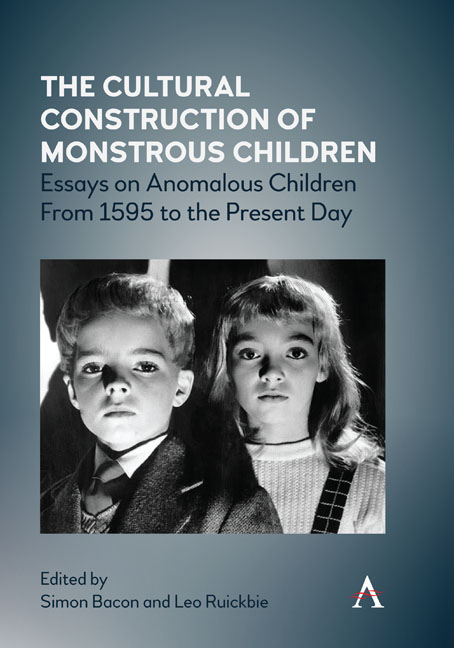 The Cultural Construction of Monstrous Children
The Cultural Construction of Monstrous Children Book contents
- Frontmatter
- Contents
- List of Illustrations
- Acknowledgements
- Introduction
- Part I Historical Case Studies
- Part II Factual Anxiety in Fictional Representations: The Undead Child
- Part III Factual Anxiety in Fictional Representations: The Monstrous Child
- Part IV Cultural Categorization in the Past, Present and Possible Future
- Notes on Contributors
- Index
Chapter Seven - Children for Ever! Monsters of Eternal Youth and the Reification of Childhood
Published online by Cambridge University Press: 20 January 2022
- Frontmatter
- Contents
- List of Illustrations
- Acknowledgements
- Introduction
- Part I Historical Case Studies
- Part II Factual Anxiety in Fictional Representations: The Undead Child
- Part III Factual Anxiety in Fictional Representations: The Monstrous Child
- Part IV Cultural Categorization in the Past, Present and Possible Future
- Notes on Contributors
- Index
Summary
Introduction
The present chapter looks at the representation of the eternal child in popular culture at the end of the twentieth and start of the twenty-first century. Particular attention is paid to its manifestation within the horror genre, and the focus of the following analysis is on how certain narratives show this immortally unchanging child becoming horrific. As the chapter argues, the monstrous child cannot escape the reified category of childhood imposed upon it by a patriarchal society, and thus, in turn, that monstrosity infects the culture around it: reified here in the sense of a category whose definition is fixed, absolutely, and not open to negotiation or evolution in anyway.
The connection between children, horror films and narratives is not a new one, but more recent examples within the genre reveal a growing anxiety around the nature of childhood itself. While childhood, at least from the late nineteenth century upwards, is a term often caught between ideas of nostalgia and idealization, exploitation and desire, it has recently come under increased scrutiny as a category which proscribes very particular rights and definitions of/for those that are deemed to belong to it. These increasing attempts to identify exactly what constitutes the category of childhood can be seen to contain and exclude those that are seen, or not seen, to ‘belong’ to it. As such the manifestos and intent of organizations such as UNICEF and the Children's Rights Movement can be seen to reify the idea of childhood, making it simultaneously protected and secure but also a signifier of difference and otherness. Such an othering sees the child as a distinct category, simultaneously making it autonomous but also a separate and, potentially, dangerous entity, consequently, causing it to be the focus of social and adult anxiety around the ‘foreign’ body that lives within it.
This reification of childhood can then be seen to find expression within horror films, where children become fixed or trapped in their ‘child’ bodies. Films and narratives, such as Devil's Backbone (2001), The Awakening (2011), Interview with the Vampire (1994), Let the Right One In (2008), Wicked Little Things (2006) and Citadel (2012), can be seen to show children who become monstrous not because of some evil or demonic force, but because they are unable to escape from the category of childhood imposed upon them.
- Type
- Chapter
- Information
- The Cultural Construction of Monstrous ChildrenEssays on Anomalous Children from 1595 to the Present Day, pp. 121 - 134Publisher: Anthem PressPrint publication year: 2020


